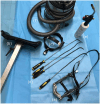Technique description and outcome evaluation of Thoroughbred racehorses following soft palate thermocautery performed under standing sedation
- PMID: 39285763
- PMCID: PMC11405922
- DOI: 10.1002/vms3.70018
Technique description and outcome evaluation of Thoroughbred racehorses following soft palate thermocautery performed under standing sedation
Abstract
Background: Palatal dysfunction (PD), which encompasses palatal instability (PI) and intermittent dorsal displacement of the soft palate, is the most common performance-limiting upper respiratory tract obstruction in young Thoroughbred racehorses. Soft palate thermocautery (SPT) performed under general anaesthesia is a routinely performed procedure for PD in some countries, but the procedure for and outcome of SPT performed under standing sedation has not been published.
Objectives: (1) To describe a technique for SPT performed under standing sedation; and (2) to assess post-operative performance in horses compared to controls using the Racing Post rating (RPR), British Horseracing Authority official rating (OR), Performance Index and Earnings.
Study design: Retrospective case series.
Methods: Medical records were reviewed for all horses that had SPT performed under standing sedation following topical and local infusion of lidocaine hydrochloride into the rostral soft palate, and that were identified to have PI by overground endoscopy. Two matched controls were identified for each case. The median RPR, OR, Performance Index and Earnings for the three pre-operative and three post-operative races were compared.
Results: No significant differences were identified between the SPT (n = 23) and Control groups (n = 46) for baseline characteristics or outcomes.
Main limitations: Retrospective study design, small sample size.
Conclusions: No significant differences in racing performance were identified between horses that had SPT performed under standing sedation and controls.
Keywords: anaesthesia; endoscopy; equid; equine; respiratory tract; surgery.
© 2024 The Author(s). Veterinary Medicine and Science published by John Wiley & Sons Ltd.
Conflict of interest statement
The authors declare no conflicts of interest.
Figures



Similar articles
-
Overground endoscopic examination following laryngeal tie-forward in horses with dorsal displacement of the soft palate.Vet Surg. 2025 Aug;54(6):1053-1061. doi: 10.1111/vsu.14245. Epub 2025 Mar 18. Vet Surg. 2025. PMID: 40099351
-
Racing performance of National Hunt thoroughbred racehorses after treatment of palatal dysfunction with a laryngeal tie-forward procedure and thermocautery of the soft palate with or without aryepiglottic folds resection.Vet Surg. 2020 Jan;49(1):114-123. doi: 10.1111/vsu.13321. Epub 2019 Sep 10. Vet Surg. 2020. PMID: 31506975
-
The use of race winnings, ratings and a performance index to assess the effect of thermocautery of the soft palate for treatment of horses with suspected intermittent dorsal displacement. A case-control study in 110 racing Thoroughbreds.Equine Vet J. 2008 Jul;40(5):508-13. doi: 10.2746/042516408X320898. Equine Vet J. 2008. PMID: 18490236
-
A systematic review of the prevalence of post-operative complications after general anaesthesia in adult horses (2000-2023).Equine Vet J. 2025 Jul;57(4):827-861. doi: 10.1111/evj.14416. Epub 2024 Oct 24. Equine Vet J. 2025. PMID: 39449518
-
Assessing the comparative effects of interventions in COPD: a tutorial on network meta-analysis for clinicians.Respir Res. 2024 Dec 21;25(1):438. doi: 10.1186/s12931-024-03056-x. Respir Res. 2024. PMID: 39709425 Free PMC article. Review.
References
-
- Allen, K. J. , Christley, R. M. , Birchall, M. A. , & Franklin, S. H. (2012). A systematic review of the efficacy of interventions for dynamic intermittent dorsal displacement of the soft palate. Equine Veterinary Journal, 44, 259–266. - PubMed
-
- Barakzai, S. Z. (2015). Is there a place for thermocautery of the soft palate? Equine Veterinary Education, 27, 387–388.
-
- Barakzai, S. Z. , Boden, L. A. , Hillyer, M. H. , Marlin, D. J. , & Dixon, P. M. (2009). Efficacy of thermal cautery for intermittent dorsal displacement of the soft palate as compared to conservatively treated horses: Results from 78 treadmill diagnosed horses. Equine Veterinary Journal, 41, 65–69. - PubMed
-
- Barakzai, S. Z. , & Dixon, P. M. (2005). Conservative treatment for thoroughbred racehorses with intermittent dorsal displacement of the soft palate. The Veterinary Record, 157, 337–340. - PubMed
-
- Barakzai, S. Z. , Finnegan, C. , & Boden, L. A. (2009). Effect of ‘tongue tie’ use on racing performance of Thoroughbreds in the United Kingdom. Equine Veterinary Journal, 41, 812–816. - PubMed
MeSH terms
Substances
LinkOut - more resources
Full Text Sources
Research Materials
Miscellaneous

